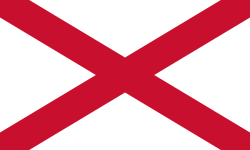
Saint Patrick's Saltire or Saint Patrick's Cross is a red saltire (X-shaped cross) on a white field. In heraldic language, it may be blazoned argent, a saltire gules. Saint Patrick's Flag (Irish: Bratach Naomh Pádraig) is a flag composed of Saint Patrick's Saltire. The origin of the saltire is disputed. Its association with Saint Patrick dates from the 1780s, when the Anglo-Irish Order of Saint Patrick adopted it as an emblem.[1] This was a British chivalric order established in 1783 by George III. It has been suggested that it derives from the arms of the powerful Geraldine or FitzGerald dynasty.[2][3][dubious – discuss] Some Irish nationalists and others reject its use to represent Ireland as a "British invention"[2] "for a people who had never used it".[4]
After its adoption by the Order of Saint Patrick, it began to be used by other institutions. When the Acts of Union 1800 joined the Kingdom of Ireland with the Kingdom of Great Britain, the saltire was added to the British flag to form the Union Flag still used by the United Kingdom. The saltire has occasionally served unofficially to represent Northern Ireland and also appears in some royal events.[5]
- ^ "Cross of St Patrick: 'Unity flag' for Northern Ireland?". BBC News. 20 July 2016.
- ^ a b Hayes-McCoy 1979, p. 38.
- ^ Perrin, W.G. (1922). "II. Early English, Scottish and Irish Flags § (iii) Ireland". British Flags, Their Early History, and Their Development at Sea: With an Account of the Origin of the Flag as a National Device. Cambridge Naval and Military Series. Illustrated by Herbert S. Vaughan. Cambridge: Cambridge University Press. pp. 51–52. ASIN B0017D3OU2. LCCN 22011380. OCLC 1614066. OL 13519843M.
- ^ Murray Pittock (1999). "1". Celtic Identity and the British Image. Manchester University Press. p. 52. ISBN 978-0-7190-5826-4.
- ^ Bartram, Graham (2012). "A Visual Guide to the Flags used in the Thames Diamond Jubilee Pageant" (PDF). Flag Institute. p. 5. Archived from the original (PDF) on 8 November 2012. Retrieved 22 August 2015.